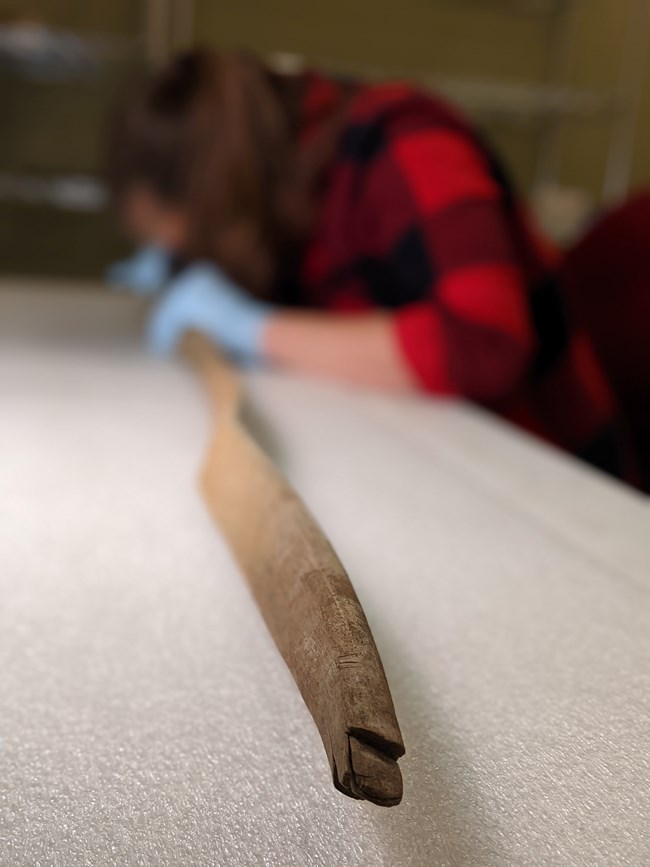Article
Historic Wooden Hunting Bow Found in Lake Clark

NPS/P. Stolen
In late September 2021, National Park Service employees found a carved wooden hunting bow in the waters of an inland lake inside Lake Clark National Park and Preserve. The well-crafted bow measures 54 inches from tip to tip and is in a good state of preservation. Following the discovery, the bow was transported to the National Park Service’s Alaska Regional Curatorial Center in Anchorage, where it is currently undergoing analysis and conservation treatment.
Archeologists submitted a small sample of the bow for radiocarbon dating analysis in early March 2022. The results indicate that the bow is approximately 460 years old with a date range between AD 1506 and AD 1660. National Park Service staff are continuing to consult with Elders and research this discovery by comparing the bow with similar artifacts held in museums in Alaska and beyond. The park is also consulting with museum conservators and preservation experts to ensure the bow is well preserved.
Preliminary research suggests the bow is most likely made of spruce and may represent a Yup’ik or Alutiiq style bow, more commonly made in Western Alaska or on the Alaska Peninsula than in the Lake Clark region; however, the NPS is just beginning to study this object. While Lake Clark National Park is primarily the ancestral homeland of the Dena’ina people for thousands of years, Yup’ik speaking people have resided nearby, along the southern and western shores of Lake Iliamna. For the Dena’ina people, trading and sharing knowledge with their Yup’ik neighbors as well as other groups such as the Tanana, Tlingit, Ahtna, Deg Hit’an and coastal residents of Prince William Sound and Kodiak was common.
Dena’ina expert George Alexie recalls his grandfather talking about the wood used to make bows:
“'My Chuda Alexie (Evan) said that when they would get the material for building the bow, they would go to the mountains. The trees (spruce) up there are a lot stronger because of the wind. The wind blowing the trees makes them bend, so that makes the wood stronger. They used to tell stories about hunting with bow and arrows and times when they used them for wars.”
Cultural practices from around the world and Western science back up Alexie Evan’s lesson—compression wood, which is the wood from the underside curve of a coniferous tree like a spruce growing in a slanted position, has long been a favorite for making bows across many northern cultures, from Greenland to Alaska to Scandinavia.
In October, the Lake Clark Museum Curator reached out to the United States Forest Service for wood identification consultation. Dr. Priscilla Morris, Wood Biomass and Utilization Coordinator inspected the artifact at the National Park Service Alaska Regional Curatorial Center:
“After inspecting the artifact, I am leaning towards spruce. Using the hand lens there were certain anatomic characteristics that lead me to believe spruce is the most likely species. There is presence of sap along with a multitude of small knots. Birch is also a suspected species, but I did not see any anatomical characteristics that lead me to believe birch over spruce.”
“Identifying a wood species of this age is tough. Many times a concrete identification requires looking at a (cut up) sample of the artifact underneath a microscope. Until that time comes, all we can rely on is what we can see underneath a hand lens.” —Dr. Priscilla Morris
The Lake Clark park staff are excited to share the news of this discovery! Insights from local Elders and community members would be greatly appreciated if known; you may contact the park via email. (e-mail us) Park staff will inform the public in the future as more is known about this exciting piece of history.
